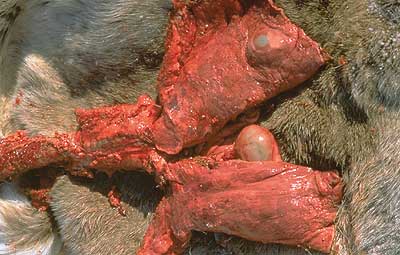Parasites and Diseases
Cystic Hydatid Disease
A Field Guide
TO COMMON WILDLIFE DISEASES
AND PARASITES IN ALASKA
CYSTIC HYDATID DISEASE

Two hydatid cysts in moose lungs.
| What causes hydatid disease? |
- Cystic hydatid disease is caused by the larvae of the tapeworm Echinococcus granulosus.
- Lifecycle: The tapeworm needs two hosts: a carnivore (e.g., wolf or dog) and a herbivore (e.g., caribou). The adult tapeworm grows and lays eggs in the intestines of the carnivore. The eggs come out in the carnivore’s droppings and contaminate plants which are eaten by the herbivore. The eggs hatch into larvae that travel to the herbivore’s lungs where they form cysts. Carnivores become infected when they eat lungs that contain cysts.
| Where does hydatid disease occur? |
- The adult tapeworm occurs in the intestines of wolves and dogs.
- The larval form or cyst occurs in moose, caribou, bison, elk and deer, and can occur in humans.
- In Alaska cystic hydatid disease occurs commonly in moose and caribou.
| What are the signs of hydatid disease? |
- Carnivores (e.g., wolves) and herbivores (e.g., moose) usually appear healthy.
- In moose and caribou, the cysts have thick walls and are filled with a clear watery liquid.
- Cysts are usually found in the lungs but can also occur in the liver or other organs.
- Cysts can be ¾ to 4 inches in diameter, but most are ¾ to 2½ inches.
- The surrounding tissue is usually normal.
| How can I protect myself? |
- You can be infected from tapeworm eggs found in the droppings of wolves and dogs.
- Wear gloves when handling scats from wolves or foxes.
- The lung cysts in moose and caribou do not infect people.
- Worm dogs regularly, keep dog lots clean and dispose of dog feces to minimize exposure to eggs of this parasite. Also, use care when handling dog harnesses and other gear that may be contaminated with Echinococcus eggs.
- When skinning wolves and foxes, keep in mind that the eggs of this parasite can cling to the fur around their tail and anus.
| Can I eat the meat? |
- Meat from infected animals is suitable for human consumption.
- Do not eat any tissues or organs containing cysts.
- Dogs and wolves can be infected from eating cysts in organs of moose or caribou and spread the disease to people in their droppings.
- Do not feed infected parts to dogs.
| Samples to collect |
- Portions of tissue containing cysts
- To report an occurrence or to submit a sample for identification/analysis, contact the DWC Wildlife Disease Surveillance reporting hotline 907-328-8354, send an email to dfg.dwc.vet@alaska.gov or visit your local ADF&G office.
